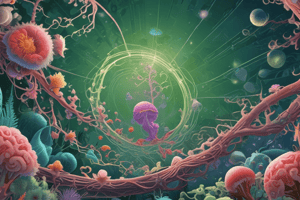Podcast
Questions and Answers
What is biology the science of?
What is biology the science of?
Life forms and living processes
Which of the following is a common feature of inanimate and animate objects?
Which of the following is a common feature of inanimate and animate objects?
- Sense of awe (correct)
- Ability to reproduce
- Photosynthesis
- None of the above
Who is known as 'The Darwin of the 20th century'?
Who is known as 'The Darwin of the 20th century'?
Ernst Mayr
What prizes did Ernst Mayr receive that are widely regarded as the triple crown of biology?
What prizes did Ernst Mayr receive that are widely regarded as the triple crown of biology?
Ernst Mayr died at the age of 100.
Ernst Mayr died at the age of 100.
What question does the diversity in the living world make us reflect on?
What question does the diversity in the living world make us reflect on?
What range of habitats can living organisms be found in?
What range of habitats can living organisms be found in?
What is biology?
What is biology?
What type of organisms can be perceived as living?
What type of organisms can be perceived as living?
The systematic description of life forms leads to the recognition of similarities among living organisms.
The systematic description of life forms leads to the recognition of similarities among living organisms.
Ernst Mayr was called 'The ______ of the 20th century'.
Ernst Mayr was called 'The ______ of the 20th century'.
When did Ernst Mayr retire?
When did Ernst Mayr retire?
Which prizes are considered the triple crown of biology?
Which prizes are considered the triple crown of biology?
What does the diversity in the living world evoke in humans?
What does the diversity in the living world evoke in humans?
Ecological conflict and cooperation among members of a ______ or among populations make us reflect on life.
Ecological conflict and cooperation among members of a ______ or among populations make us reflect on life.
Flashcards are hidden until you start studying
Study Notes
Overview of Biological Diversity
- Biology studies life forms and processes, highlighting the vast diversity of living organisms.
- Early humans recognized the distinction between living and inanimate matter, often attributing divine significance to elements of nature and certain animals.
Importance of Classification
- Detailed classification and identification of organisms emerged out of the necessity to understand biological diversity.
- Recognizing similarities among organisms, both horizontally (across different species) and vertically (across evolutionary history), fosters appreciation for biodiversity.
- This understanding has led to cultural movements aimed at conserving biodiversity.
Ernst Mayr's Contributions
- Born on July 5, 1904, in Kempten, Germany, Ernst Mayr was a pivotal figure in evolutionary biology, earning the title "The Darwin of the 20th century."
- Joined Harvard in 1953 as the Alexander Agassiz Professor of Zoology Emeritus and continued to influence biology until his retirement in 1975.
- Mayr's extensive research encompassed ornithology, taxonomy, zoogeography, and the philosophy of biology.
- He emphasized the origin of species diversity as a central question in evolutionary biology and defined the modern concept of biological species.
- Awarded prestigious prizes: Balzan Prize (1983), International Prize for Biology (1994), and Crafoord Prize (1999).
- Mayr lived to be 100 years old, passing away in 2004.
The Living World
- The living world's diversity is extraordinary, spanning various habitats such as mountains, forests, oceans, and deserts.
- Each habitat showcases unique forms of life, eliciting awe and wonder.
- The dynamics of ecological interactions—cooperation and conflict—between organisms in populations and communities highlight the complexity of life.
- Understanding life encompasses both technical aspects (defining living vs. non-living) and philosophical inquiries about the purpose of life.
Exploring Diversity
- Observable diversity includes potted plants, insects, birds, and various animals; however, many organisms are microscopic.
- The question of what constitutes living organisms prompts a deeper reflection on the essence of life itself.
Overview of Biological Diversity
- Biology studies life forms and processes, highlighting the vast diversity of living organisms.
- Early humans recognized the distinction between living and inanimate matter, often attributing divine significance to elements of nature and certain animals.
Importance of Classification
- Detailed classification and identification of organisms emerged out of the necessity to understand biological diversity.
- Recognizing similarities among organisms, both horizontally (across different species) and vertically (across evolutionary history), fosters appreciation for biodiversity.
- This understanding has led to cultural movements aimed at conserving biodiversity.
Ernst Mayr's Contributions
- Born on July 5, 1904, in Kempten, Germany, Ernst Mayr was a pivotal figure in evolutionary biology, earning the title "The Darwin of the 20th century."
- Joined Harvard in 1953 as the Alexander Agassiz Professor of Zoology Emeritus and continued to influence biology until his retirement in 1975.
- Mayr's extensive research encompassed ornithology, taxonomy, zoogeography, and the philosophy of biology.
- He emphasized the origin of species diversity as a central question in evolutionary biology and defined the modern concept of biological species.
- Awarded prestigious prizes: Balzan Prize (1983), International Prize for Biology (1994), and Crafoord Prize (1999).
- Mayr lived to be 100 years old, passing away in 2004.
The Living World
- The living world's diversity is extraordinary, spanning various habitats such as mountains, forests, oceans, and deserts.
- Each habitat showcases unique forms of life, eliciting awe and wonder.
- The dynamics of ecological interactions—cooperation and conflict—between organisms in populations and communities highlight the complexity of life.
- Understanding life encompasses both technical aspects (defining living vs. non-living) and philosophical inquiries about the purpose of life.
Exploring Diversity
- Observable diversity includes potted plants, insects, birds, and various animals; however, many organisms are microscopic.
- The question of what constitutes living organisms prompts a deeper reflection on the essence of life itself.
Studying That Suits You
Use AI to generate personalized quizzes and flashcards to suit your learning preferences.



